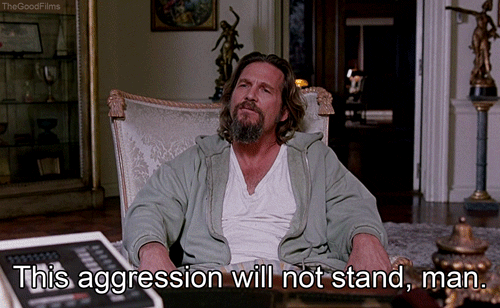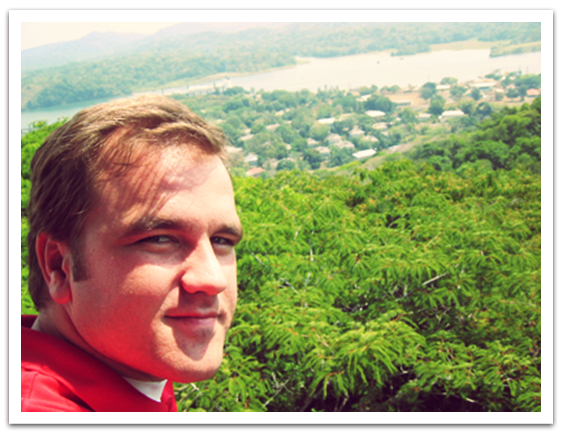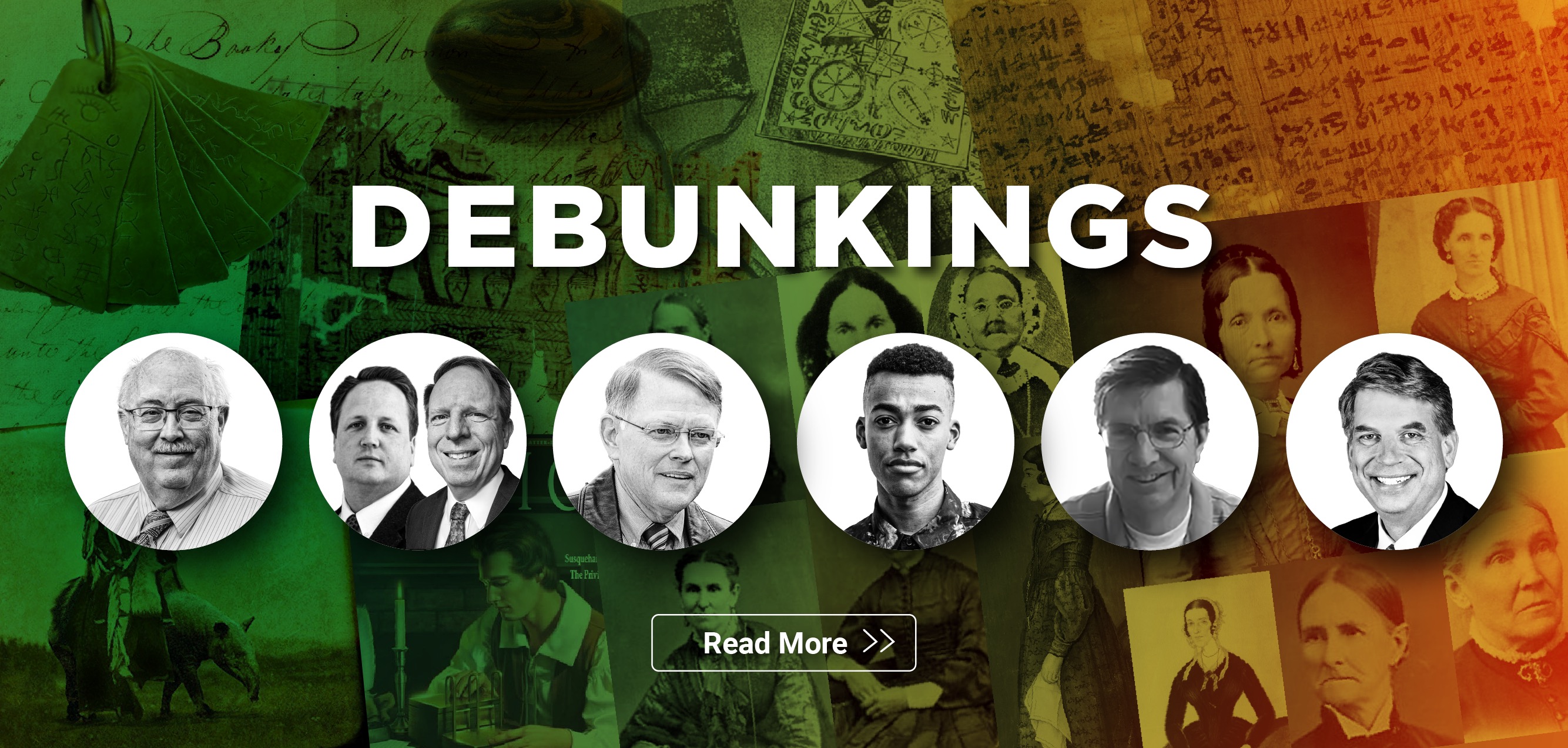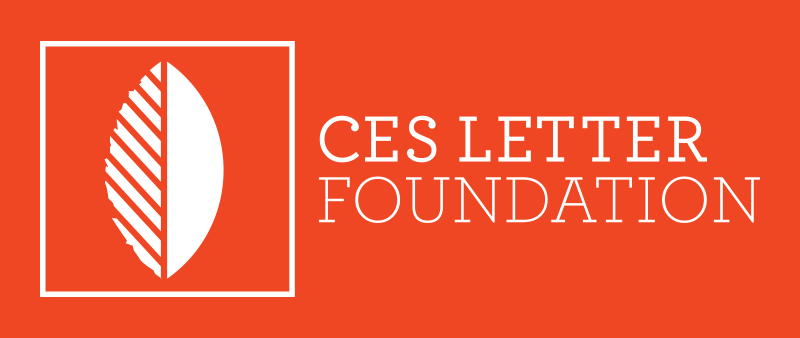Detailed Response
CES Letter Conclusion
Among the first sources I looked to for answers were official Church sources...I couldn’t find them.
"When I first discovered that Joseph Smith used a rock in a hat to translate the Book of Mormon, that he was married to 11 other men’s wives, and that the Book of Abraham has absolutely nothing to do with the papyri or facsimiles…I went into a panic. I desperately needed answers and I needed them 3 hours ago. Among the first sources I looked to for answers were official Church sources such as Mormon.org and LDS.org. I couldn’t find them."
- FairMormon agrees that Joseph Smith used a rock in a hat for translating BOM.
- FairMormon agrees that he was married to 11 other living men’s wives.
- FairMormon agrees that papyri and Facsimiles do not match the Book of Abraham text.
- FairMormon acknowledges that Church is not transparent on “polyandry”.
- FairMormon provides no sources on how Church is transparent with polygamy.
- FairMormon disagrees with “I looked for answers from official Church sources such as Mormon.org and LDS.org. I couldn’t find them.”
- FairMormon claims transparency from Church with rock in hat, which I discuss here.
- FairMormon claims that obscure 25-45 year old articles (one which is no longer hosted on Church owned servers) are examples of Church transparency on the Book of Abraham.
Correct:
We found no mention of marriages to ‘11 other men’s wives,’ on lds.org. We did find a number of mentions of plural marriage.
Note: FairMormon deleted the following FairMormon response on July 14, 2013:
There are a number of mentions of plural marriage, some to young women, on lds.org.
FairMormon deleted their above response. See screenshot.
Jeremy's Response
Notice that FairMormon says that they find no mention of “11 other men’s wives” on lds.org and leaves it at that. There is nothing on lds.org, mormon.org, or anywhere in official sources about “polyandry” either.
In fact, the first result you get when you search for “polyandry” on LDS.org is an article about laundry tips:
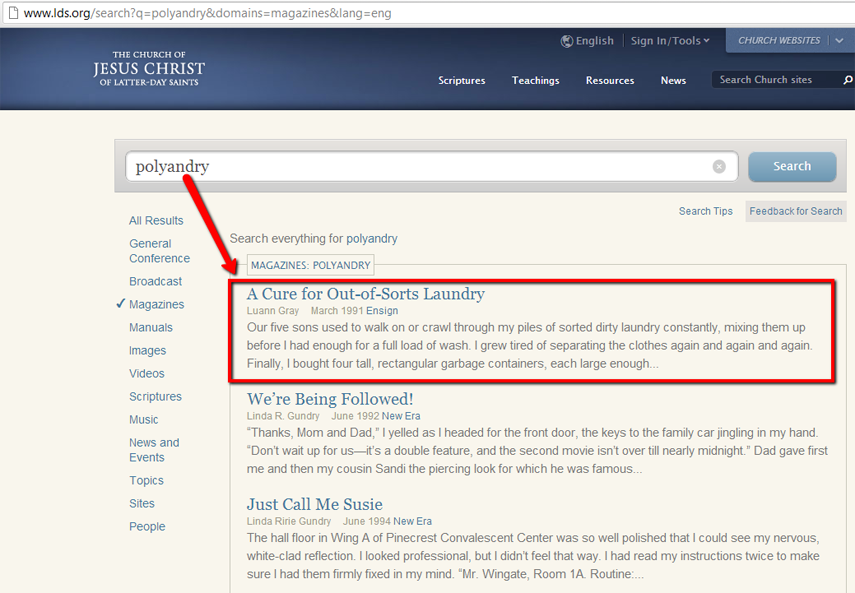
If the Church had an official response to polyandry and Joseph’s 11 polyandrous marriages, you’d definitely hear about it from FairMormon.
This is an admission by FairMormon that the Church is not transparent to their members about the polyandrous (wives with multiple husbands) marriages of Joseph Smith.
I find it very disingenuous the way FairMormon responded above to the polyandry. FairMormon states there is no mention of “11 other men’s wives” while not offering to their readers that there are no mentions of “polyandry” by the Church anywhere either.
FairMormon is incorrect with their “there are a number of mentions of plural marriages” claim. Notice that FairMormon does not offer sources to support their claims of open transparency about plural marriage like they do with the Book of Mormon translation and the Book of Abraham.
Perhaps the real reason why FairMormon does not offer sources on polygamy? FairMormon learned their lesson in March 2012 when the president of FairMormon, Scott Gordon, pulled the same botched stunt on polygamy like he did with the rock in the hat translation sources:
Out of the 7 sources given by FairMormon in this presentation as proof that the Church is being transparent and honest to members about Joseph Smith’s polygamy, only one of the sources – Ensign December 1978, p. 42 – checks out. FairMormon is dishonest in claiming that there are “a number of [official] mentions of plural marriages” of Joseph Smith.
In any event, FairMormon’s ineffective attempt to show that the Church has been transparent is an implicit acknowledgment by FairMormon that the Church should be transparent. Clearly it should, and clearly it hasn’t.
Doesn’t count: - Critics like to claim the Church never or rarely does something, and then insist that every counter-example doesn’t really count (if they mention them at all). This lets them ignore all evidence contrary to their position.
We found the following mentions of a seer stone being used to translate the Book of Mormon, with a few mentions of the hat, on lds.org:
FairMormon then lists all of the rock in the hat sources cited in the Book of Mormon Translation section.
FairMormon deleted their above response. See screenshot.
Jeremy's Response
“This lets them ignore all evidence contrary to their position.”
What evidence? FairMormon’s evidence of the Church being transparent of the rock in the hat consists of two three (including the Church's brand new essay) single sources given in 40+ years. FairMormon provides no sources for polygamy/polyandry. And the best FairMormon can do with the Book of Abraham are obscure articles from between 1968 and 1988, which only obfuscate the problems of the Book of Abraham further.
FairMormon then points to the same sources contained in the Book of Mormon Translation section, which I go over individually one by one. In that section, I illustrate how out of the 8 sources FairMormon gives, only 6 are official sources. Out of those 6 official sources that FairMormon gives, only 2 clearly state the rock in the hat method. None of the sources are from General Conference talks or lesson manuals. Two thirds of the official sources FairMormon give as “proof” of the Church’s honesty and transparency to their members about how the Book of Mormon was really translated are not even official, clear, or good sources.
In the 40 year time frame of those given sources, only two of the sources (1977 and 1993 Ensigns) quote the one sentence from David Whitmer that “Joseph Smith would put the seer stone in a hat and put his face in the hat, drawing it closely around his face to exclude the light.” January 2014 Note: The Church just released a brand new Book of Mormon Translation essay.
This one quote creates more questions than answers. Questions such as:
- Where does this hat come from?
- Why is Joseph using a hat?
- Where does this stone come from?
- When did Joseph find the stone?
- Is this stone actually the Urim and Thummim? Wasn’t that removed along with the plates upon the loss of the 116 pages?
- Why is Joseph using a stone in a hat?
- Why were no gold plates used for the Book of Mormon we have today?
- Is this the same rock in a hat method that Joseph used as a treasure hunter?
- Why is what the Church telling me how the Book of Mormon translation happened versus what the primary historical documents show actually happened so different?
If the Church was and is truly interested in being transparent to members and investigators in how the Book of Mormon was actually translated, they would not resort to just leaving members and investigators hanging to hunt down extremely obscure sources in an archive spanning 40+ years only to end up with the only clear sources being David Whitmer’s one sentence quote in a 1977 and 1993 Ensign article over a time frame of 40 years’ worth of General Conference talks, speeches, lessons, and Ensign articles. January 2014 Note: The Church just released a brand new Book of Mormon Translation essay.
If the Church was really truly interested in being honest and transparent to their members and investigators about how the Book of Mormon was really translated, it would not be displaying – still in 2014 – the following paintings that millions of members and investigators pass through and view annually:
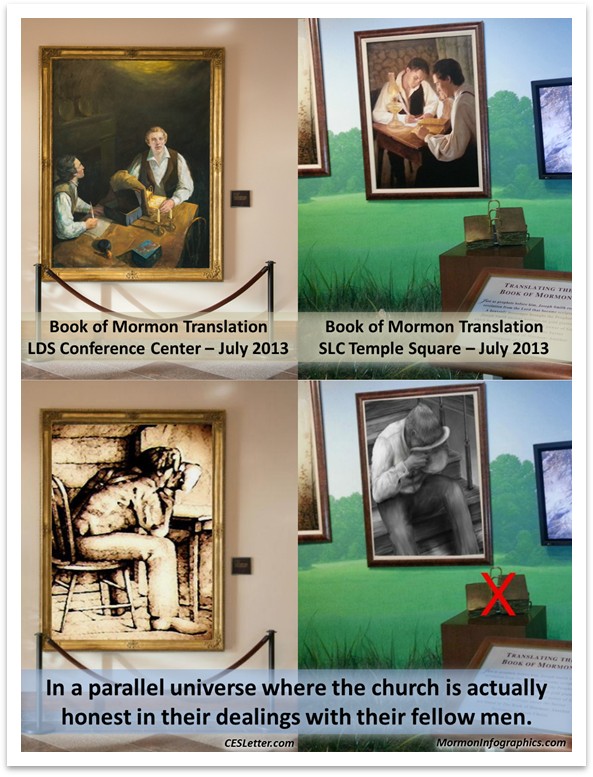
We found the following mentions that the Joseph Smith papyri does not contain the text of the Book of Abraham on lds.org:
March 1976 Ensign: “A Book of Breathings text that closely matches the Joseph Smith version (and there are precious few of them) is the so-called Kerasher Book of Breathings. It too has a frontispiece, only in this case it is the same as our Facsimile No. 3, showing that it too is closely associated with our text.”
FairMormon deleted their above response. See screenshot.
Jeremy's Response
In doing an internal lds.org search for “Book of Abraham,” I could not locate this March 1976 Ensign article until page 5 of my search results. If this is the Church’s and FairMormon’s standard for transparency to the members? I’m unimpressed.
What’s the first thing that I read when I open this article? A disclaimer:
“Questions of general gospel interest answered for guidance, not as official statements of Church policy.”
So, the very first thing on this source that FairMormon claims is evidence that the Church is transparent to its members is a disclaimer that it’s not official.
In reading the article, it’s filled with nonsense such as “The facsimiles confirm the book of Abraham and place before our eyes a present and tangible tie with the patriarch himself.” Actually, it doesn’t. Even FairMormon won’t stand behind this statement. Not only do the facsimiles not confirm the Book of Abraham, they’re tangible objects that have nothing to do with the patriarch himself or anything Joseph Smith claimed them to be as Egyptologists point out that Joseph’s reconstruction and “translations” of the facsimiles are complete and utter nonsense.
We found the following mentions that the Joseph Smith papyri does not contain the text of the Book of Abraham on lds.org:
July 1988 Ensign: “Why doesn’t the translation of the Egyptian papyri found in 1967 match the text of the Book of Abraham in the Pearl of Great Price?”
FairMormon deleted their above response. See screenshot.
Jeremy's Response
When I search for “Book of Abraham” in the internal search on lds.org, this and the other 2 articles are nowhere to be found. I then click on “All results from Top Results on ‘book of abraham’” and I do not see this article until close to the 9th spot on page 1 of the expanded results. This is the Church’s new search engine. I recall looking for the same article months ago and it was not even on the first page.
Like the March 1976 article, there is a disclaimer in the header of the article which states that the statements in this article are not official statements of Church policy.
Here is a rebuttal to both the March 1976 and July 1988 Ensign articles.
The following is contained in the online archive of the Improvement Era:
August 1968 Improvement Era: “The largest part of the papyri in possession of the Church consists of fragments from the Egyptian Book of the Dead.”
FairMormon deleted their above response. See screenshot.
Jeremy's Response
You cannot find this on lds.org or on any official Church website. In fact, you have to hunt it down on the internet. Once again, Google delivers where the Church does not. FairMormon states: “The following is contained in the online archive of the Improvement Era." FairMormon doesn’t tell the reader that this “online archive” is a non-LDS website archive.org that you have to do a Google search to locate. In other words, it’s archived and hidden off the official LDS websites and servers. A member or investigator in 2014 has no way of knowing about this archived article written 45 years ago unless they’re specifically aware of this document, its title, and what to search for. I have never heard of this article as a believing member and neither have several LDS friends I’ve asked (age range: 16–57).
Notice that FairMormon links to the March 1976 and July 1988 Ensign articles but not to the August 1968 Improvement Era in their source reference.
FairMormon points to the August 1968 Improvement Era as yet further proof of the Church’s transparency while ironically neglecting to note that there is no way for a member or investigator to find this unless they’re very specifically told about it, its title, and its publication date.
It is beyond absurd that we’re supposed to take FairMormon seriously that these obscure articles published 20-45 years ago, which mostly contain a paragraph here or a sentence there, are proof that the LDS Church is transparent to their members and investigators in 2014 about the serious problems of the Book of Abraham.
The following is a video of FairMormon's President, Scott Gordon, in a Q&A with John Dehlin of Mormon Stories discussing honesty and transparency in the Church. It's well worth watching and listening to (pay close attention to Scott's body language, facial expressions, and comments during the exchange):
FairMormon…has done more to destroy my testimony than any anti-Mormon source could
"FairMormon and these unofficial apologists have done more to destroy my testimony than any anti-Mormon source ever could. I found their version of Mormonism to be alien and foreign to the Chapel Mormonism that I grew up in attending Church, seminary, reading scriptures, General Conferences, EFY, mission, and BYU. Their answers are not only contradictory to the scriptures and teachings I learned through correlated Mormonism…they’re truly bizarre."
- I put “neutral” because FairMormon clearly either does not understand my argument or FairMormon is misrepresenting my argument.
Caricature believers' arguments - Rather than accurately report and respond to a statement offered by a believer, the critic misrepresents it and then criticizes their own straw man version.
The author, after noting that he was troubled by Elder Nelson's talk in the Ensign which mentioned Joseph's use of a stone in a hat, said that "FairMormon confirms polyandry and the rock in the hat translation. Both of these issues usually cause severe cog dis in members. They did with me." In other words, he thinks that FairMormon should deny that these things happened. One should not reasonably expect FairMormon to deny things that are printed in the Ensign, such as Elder Nelson's talk which mentions the stone in the hat. How, then, did FairMormon do "more to destroy" his testimony than any anti-Mormon source ever could? (This actually reflects a popular and common meme among online ex-Mormons that tries to cast FairMormon as an "anti-Mormon" site. The promotion of this idea is well represented in "A Letter to a CES Director.")
FairMormon deleted their above response. See screenshot.
Jeremy's Response
FairMormon creates a strawman fallacy by misrepresenting my argument. FairMormon is either unwilling or unable to comprehend that they are in a state of apostasy. They are either unable or unwilling to get that their brand of Mormonism is at direct odds with the Chapel Mormonism taught by “prophets, seers, and revelators,” scriptures, Sunday schools, Ensigns, and General Conferences.
The way FairMormon misrepresents my argument is by pinning everything on a comment that I made online on April 30, 2013; over a year after my faith crisis started and over 10 months after I stopped believing in the Church. It’s much, much more than FairMormon honestly legitimizing the issues (which I take my hat off to FairMormon and applaud them for).
The problem is not just FairMormon’s honesty in validating the legitimacy of many of the problems (again, this is what FairMormon should do and I commend them for this). The problem is what FairMormon does after acknowledging the troubling facts. FairMormon creates this warped and bizarre version of Mormonism that is very difficult for many Chapel Mormons to swallow, digest, and accept.
FairMormon destroys testimonies in the following 5 ways:
- FairMormon confirms and legitimizes the problems of Mormonism shared by critics. This is inevitable and unavoidable. FairMormon is actually doing what the Church is supposed to be doing by owning and being transparent to their members about these very problematic facts and issues. A natural byproduct of FairMormon being mostly upfront and honest by acknowledging the legitimacy of these issues and problems is often the loss of faith and trust of Mormons in the LDS Church and its leadership.
- FairMormon introduces additional problems (also unavoidable).
- Many find FairMormon’s answers unsatisfying and confusing, which in turn only create more questions and more concerns.
- Many find FairMormon’s tone and tactics to be un-Christlike and offensive. FairMormon is notorious for ad hominem attacks. FairMormon commits several ad hominem attacks on me in their response. This is especially evident in their false characterization and attack on my integrity and character in this section (CES Conclusion). Another example of this is FairMormon’s introduction in its critique of the website Mormonthink, available here. FairMormon’s introduction begins by quoting some arguably inflammatory statements by former and current editors (from various internet sources) of Mormonthink, shifting the focus away from the merits of the website and onto the editors themselves. FairMormon takes the same tactic against me, as explained below.
- FairMormon presents a bizarre version of Mormonism. In order for Mormons to embrace FairMormon’s apostate Mormonism, they have to go back to the drawing board and redesign their paradigm to somehow work with a befuddled and foreign Mormonism contrary to the Mormonism they once had a testimony of. FairMormon’s Mormonism requires serious mental gymnastics to ignore glaringly obvious contradictions and inconsistencies with Chapel Mormonism, prophets, and scriptures.
The reason why the claim that “FairMormon is where testimonies go to die” is popular among ex Mormons is because it is the overwhelmingly common experience of the majority of ex Mormons and New Order Mormons (active disbelieving Mormons) who went to FairMormon for a lifeline early in their faith crises. This is a fact that FairMormon cannot compute as they fail to really grasp how their version of Mormonism is apostate and contradictory to LDS prophets, scriptures, and Church teachings. Since many of FairMormon’s teachings directly contradict prophets, doctrine, and scriptures, FairMormon is in a direct state of apostasy. This is why FairMormon is often referred to as an “anti-Mormon” website by ex-Mormons and even by believing active Chapel Mormons who disagree with FairMormon’s bizarre brand of Mormonism.
Mormon Stories John Dehlin discusses #1-4 of the above list in addition to the problems of FairMormon and the Neal A. Maxwell Institute apologetics in the following video:
(Starts @ 30:16)
FairMormon comment deleted by FairMormon on July 28, 2013:
A common theme on ex-Mormon boards is that the answers to these questions must come from ‘official’ Church sources and not "unofficial" sources such as FairMormon or the Maxwell Institute.
Jeremy's Response
FairMormon does not speak for the Church. The Church does not officially back or support FairMormon. FairMormon’s answers are just opinion and speculation unless they only contain official responses from the Church. The only answers that matter at the end of the day are the official answers given by the Church and its official and authorized representatives. Otherwise, “prophets, seers, and revelators” have to compete for the spotlight with the likes of FairMormon and Rodney Meldrum.
If the Church and its leaders will not stand behind these unofficial apologists and their opinions/speculations, why then should we accept or even entertain the answers of these unofficial apologists if the very Church and leadership they’re defending won’t even stand behind them?
If FairMormon’s answers are so good, why isn’t the Church using or modeling FairMormon’s answers to the problems of Mormonism in a FAQ style lds.org page similar to mormon.org/faq?
It’s common theme in the Church and especially in the Mormon Public Relations Department that no one speaks for or on behalf of the Church except for the Church and its official representatives. FairMormon is attempting to redefine decades of LDS corporate and Public Relations policies and practices.
It is clear from his statements online (shown below) that he went to MormonThink and online discussion boards first. It is also evident that the author is only familiar selected quotes from a variety of primary sources (including lds.org) that are included on critical websites.
FairMormon comment deleted by FairMormon on July 20, 2013:
The author had already reached his conclusions about the Church and lost his testimony before he went to FairMormon. Based upon his statements, he went to MormonThink and lds.org first. The following statements posted by the author on the ex-Mormon subreddit show his line of thinking. How did the author conclude that FairMormon ‘did more to destroy his testimony than any anti-Mormon source ever could’, when he claims that he visited FairMormon after he wrote the CES Letter?
FairMormon deleted their above response. See screenshot.
Jeremy's Response
FairMormon is incorrect. FairMormon is being dishonest and deceptive here in their attempt to discredit me and the CES Letter.
The following is a screenshot of page 5 in the CES Letter:
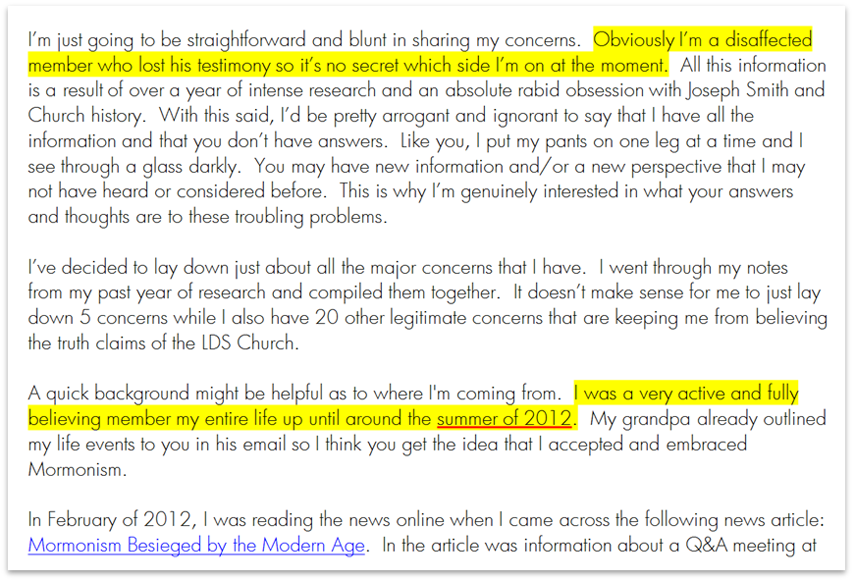
The following is a timeline of my disaffection:

Each and every one of the following quotes that FairMormon quotes me on is dated on and after October 2, 2012. As I stated in the above screenshot of page 5 in the CES Letter, I stopped believing in the Church and its truth claims in the summer of 2012; months before the Reddit quotes were written.
My crisis of faith started in February 2012 and I stopped believing in the summer of 2012.
I never was deceptive or dishonest about where I was. I was upfront from the very beginning in my letter as the very subtitle of my letter is “Why I Lost My Testimony.” The following are statements by me in the CES Letter in which I’m open and honest to the CES Director and to my readers about my disbelief:
- Subtitle: “Why I Lost My Testimony”
-
Page 5: “Obviously I’m a disaffected member who lost his testimony so it’s no secret which side I’m on at the moment. All this information is a result of over a year of intense research and an absolute rabid obsession with Joseph Smith and Church history.”
FairMormon even quotes me on this in their home page Overview. FairMormon knows I’m upfront from the beginning in my CES letter about my disbelief and that I stopped believing in the summer of 2012. Why then did FairMormon misrepresent and lie about me in their “Conclusion” sub-article?
- Page 5: “I’ve decided to lay down just about all of the major concerns that I have. I went through my notes from my past year or research and compiled them together.”
- Page 5: “I was a very active and believing member my entire life up until around the summer of 2012.”
- Page 5: “In February of 2012, I was reading the news online when I came across…this truly shocked me.” I then describe what triggered the start of my faith crisis.
- Page 26: “It [Book of Abraham] is the smoking gun that has completely obliterated my testimony of Joseph Smith and his claims.”
- Page 27: “I have a problem with this [Joseph’s practice of polygamy/polyandry]. This is Warren Jeffs territory. This is not the Joseph Smith I grew up learning about in the Church and having a testimony of. This is not the Joseph Smith that I sang ‘Praise to the Man’ to or taught others about two years in the mission field.”
- Page 35: “As a believing member, I had no idea that Joseph Smith…” I refer to being a believing member in the past tense.
- Page 42: “As a believing Mormon, I saw a testimony as more than…” I refer to being a believing member in the past tense.
- Page 42: “I lost this confidence at 31-years-old when I discovered that the gap between what the Church teaches about its origins versus what the primary historical documents actually show happened…couldn’t be further apart.”
- Page 44: “After I lost my testimony, I attended a conference where former Mormons shared their stories.”
- Page 44: “Why did I feel the Spirit as I listened to the stories of apostates sharing how they discovered for themselves that Mormonism is not true?”
- Page 65: “As a believing Mormon, I tried to rationalize some of the craziness by…” I refer to being a believing Mormon in the past tense.
- Page 74: “As a believing member, I was deeply offended by the accusation that the Church was a cult…” I refer to being a believing member in the past tense.
- Page 74: “It was only after I lost my testimony and discovering…”
- Page 75: “FairMormon and these unofficial apologists have done more to destroy my testimony than any anti-Mormon source ever could.”
- Page 75: “Why is it that I had to first discover all of this – from the internet – at 31-years-old after 20 years of high activity in the Church?”
- Page 75: “How am I supposed to feel about learning about these disturbing facts at 31-years-old?”
- Page 75: “So, putting aside the absolute shock and feeling of betrayal in learning about all this information that has been kept concealed and hidden from me by the Church my entire life, I’m not expected to go back to the drawing board. Somehow, I’m supposed to rebuild my testimony on newly discovered information that is not only bizarre and alien to the Chapel Mormonism I had a testimony of; it’s almost comical.”
- Page 76: “I’m now supposed to believe…” I repeat this over and over. This indicates that I’ve lost my testimony and I disbelief the truth claims of Mormonism.
- Page 76: “I’m sorry, but faith is believing and hoping when there is little evidence for or against something. Delusion is believing when there is an abundance of evidence against something. To me, it’s absolute insanity to bet my life, my precious time, my money, my heart, and my mind into an organization that has so many problematic challenges to its foundational truth claims. There are just way too many problems. We’re not just talking about one issue here. We’re talking about dozens of serious issues that undermine the very foundation of the LDS Church and its truth claims.”
- Page 76: “The past year was the worst year of my life. I experienced a betrayal, loss, and sadness unlike anything I’ve ever known. ‘Do what is right; let the consequence follow’ now holds a completely different meaning for me. I desperately searched for answers to all of the problems.”
- Page 76: “To me, the answer eventually came but it was not what I expected…or hoped for.”
- Page 76: Poem is about faith, loss of faith and doubt, and faith transition. One part of the poem: “But now I have become a man, and doubt the promise of the plan.”
I never made any claim that “I’ve never visited FairMormon until after I wrote the CES Letter.” This is a lie by FairMormon.
FairMormon is grasping at straws here in their desperate and deceptive failed attempt to paint me as a liar who is deceiving everyone. This is an outrageous ad hominem and personal attack by FairMormon on my integrity and character.
The following is FairMormon’s continued deceptive and dishonest attack on my integrity and character:
It is clear from his statements online (shown below) that he went to MormonThink and lds.org first. It is also evident that the author is only familiar with selected quotes from a variety of primary sources that are included on critical websites.
FairMormon deleted their above response. See screenshot.
Jeremy's Response
Actually, FairMormon, it’s not. All of the following Reddit statements below were made long after my loss of testimony and belief in Mormonism in the summer of 2012. My online statements below say nothing about what sources I used or didn’t use for research in my faith crisis.
Let’s pull up the timeline again:

FairMormon’s entire premise in this section is based on incorrect assumptions. It’s based on the lie that I deceptively and dishonestly portrayed and presented myself as a believer when I wrote the CES Letter. I wasn’t a believer and I was 100% transparent about this from the first page in my letter to the CES Director; from the subtitle straight down to the very last page. Again, FairMormon’s entire argument and claims in this section are not only incorrect; they're deceptive and false.
As demonstrated with my transparency in the CES letter of no longer believing in the summer of 2012, I was very aware of primary sources from my past year of research on both sides by the time I started writing the CES Letter in March 2013 (my crisis of faith occurred a year earlier in February 2012).
Critics and critical websites do not hold a monopoly on primary sources. They’re also on pro-LDS websites and books, which sources I’ve also used in my research. The fact is that the overwhelmingly majority of my sources in the CES Letter contain LDS, LDS-friendly, and neutral sources.
This is just FairMormon’s failed attempt to paint me as the imbalanced ex-Mormon who gets his information only from critical and “anti-Mormon” websites and sources.
The author of the "CES Letter" said on October 2, 2012:
“Brigham Young said ‘The only men who become Gods, even the sons of God, are those who enter into polygamy’ (Journal of Discourses 11:269). Last I checked, Journal of Discourses is not anti-mormon.”
Jeremy's Response
Again, FairMormon misses the point. I posted this on October 2, 2012 when I stopped believing in Mormonism a few months earlier in the summer of 2012. I’m open and transparent about this fact on page 5 of the CES Letter.
FairMormon’s point is therefore moot, invalid, and pointless.
The author of ‘CES Letter’ said on October 9, 2012 in his ‘Open Letter’ to Elder Quentin L. Cook:
...Respected LDS Historian and ‘Rough Stone Rolling’ author Richard Bushman totally lied and deceived me....Elder Russell M. Nelson also endorsed this stone in hat method of translation of the Book of Mormon in his July 1993 Ensign ‘A Treasured Testament’ talk. You might want to have a quick chat with him to get his talk corrected. Like, pronto....Joseph Smith's own journals have obviously been tampered with....LDS-owned FamilySearch.org listing Joseph's teen brides....he, according to FairMormon, FARMS, FamilySearch.org and LDS historians, really did practice polygamy....that lie is in the Journal of Discourses...might want to delete it pronto....”
Jeremy's Response
FairMormon is referring to my Open Letter to Elder Cook, which I address here.
FairMormon butchers up and places my letter completely out of context while posting the letter in its entirety on the very bottom of the page in “Endnotes.”
FairMormon highlights sentences from the open letter to Elder Cook to show that I was familiar with some of the problems and sources as early as October 9, 2012 before I wrote the CES Letter. Well, of course I was familiar with many of the issues, problems, and sources in October 2012.
Unlike the lie about Thomas B. Marsh told by President Monson as a slight to those who left the Church, I didn’t leave the Church over “milk strippings.” I stopped believing because I did my homework.
By the way, FairMormon agrees that President Monson is wrong about Thomas B. Marsh:
(Starts @ 44:53 and ends @ 46:17)
As I demonstrated previously, when I posted the open letter to Elder Cook on October 9, 2012, I was already an unbeliever as I had stopped believing in Mormonism a few months prior in the summer of 2012. By October 2012, I had already done a tremendous amount of research before losing my belief and faith in the Church in the summer of 2012.
FairMormon’s point is therefore moot, invalid, and pointless.
The author of the ‘CES Letter’ said on October 11, 2012:
“Because the ‘Ouija Board’ that he used to con people in his treasure hunting days is the same ‘Ouija Board’ that he used to bring forth the Book of Mormon. Additionally, the church's spin on how the BOM came to be vs. how it actually happened are universes apart."
Jeremy's Response
FairMormon's ad hominem attacks continue.
I even said “Ouija Board” in the Book of Mormon Translation section of the CES Letter.
Again, I was no longer a believer on October 11, 2012. I shared this on page 5 in the CES Letter.
FairMormon’s point is therefore moot, invalid, and pointless.
The author of the "CES Letter" said on November 11, 2012:
“A person has to do their own convincing. Your dad is doing the research and is asking questions. Let it take its course. Hopefully you pointed him to the right resources (MormonThink.com, etc.)”
Jeremy's Response
Again, I was not a believer of the Church on November 11, 2012 when I gave the above advice to another individual’s post seeking advice about his father trying to bring him back into the Church.
The fact that I posted “MormonThink.com” nine months after my faith crisis and 4-5 months after I stopped believing in the summer of 2012 doesn’t mean anything.
Besides, I’ll leave it to my readers to decide for themselves on just how “fair” FairMormon is with MormonThink.com: www.mormonthink.com/fair.htm
FairMormon is really grasping at straws here. FairMormon’s point is moot and invalid and pointless as I already mentioned in the beginning of my letter to the CES Director that I stopped believing around 10 months before in the summer of 2012.
The author of the CES Letter said on November 15, 2012:
“I'm BIC, RM, Temple Married who left the church a few months ago (haven't resigned yet)....I have a TBM wife who still takes kids to church. I want to know the most effective way to save them from Mormonism so they won't have to go through what I went through.”
Jeremy's Response
Yet again, I was no longer a believer on November 15, 2012 when I made this statement. As explained numerous times previously, I’ve been upfront in the very beginning of my letter that I stopped believing in the Church in the summer of 2012.
In fact, this November 15, 2012 online comment validates my claim that I left in the summer of 2012 as “I left the church a few months ago.”
As for my statement, “I want to know the most effective way to save them from Mormonism so they won’t have to go through what I went through”: I went through a horrible crisis of faith and faith transition where I was caught completely and totally off-guard by LDS Church's truth crisis that the Church concealed and hid from me my entire life.
It would be nothing short of irresponsible of me to not do everything I can as a father to prevent inevitable and unnecessary suffering down the road for my children should I allow the Church to control the narrative in hiding and concealing its origins and history from my children. Allowing the Church to continue to mislead and not tell my children the truth about Joseph Smith and its origins…only to have my children get the rug pulled from under them later in their lives would be nothing short of insanity and child abuse.
FairMormon’s point is therefore moot, invalid, and pointless.
The author of the ‘CES Letter’ said on February 19, 2013:
“Yeah, reading ‘The Mormon Murders’ and other stuff about the Mark Hoffman disaster did really did some damage on how I look at Hinckley and the modern church. Specifically, the buying and hiding the embarrassing forgeries along with the lack of discernment.”
Jeremy's Response
I posted this on February 19, 2013 when I definitely no longer was a believer; about 10 months after I stopped believing in the summer of 2012, as I’ve stated in the beginning of the CES Letter.
I read “The Mormon Murders,” a book about the Mark Hofmann forgeries and murders, in May 2012 in the late stages of my faith crisis. This book was among dozens of other books I’ve read during my crisis of faith and beyond in the past year and a half.
FairMormon’s point is therefore moot, invalid, and pointless.
The author of the "CES Letter" said on February 22, 2013:
He [Elder Russell M. Nelson] quotes David Whitmer's testimony of rock in the hat translation method.
Jeremy's Response
I also posted this in the CES Letter.
I was definitely no longer a believer on February 22, 2013 when I posted this. As mentioned repeatedly above, I was upfront in the beginning of the letter regarding my disbelief in the summer of 2012.
FairMormon’s point is therefore moot, invalid, and pointless.
The author of the ‘CES Letter’ said on March 26, 2013:
“Need Feedback! My TBM grandpa asked me to speak to his CES Director friend, about my concerns. CES guy offered to talk to me. This PDF is a rough draft of what I'm sending over to both CES guy and grandpa. Need your feedback/advice, guys. Thanks!”
Jeremy's Response
Again, as mentioned in the beginning of my CES letter, I no longer believed in the summer of 2012. So, obviously I was no longer a believer when I posted this on March 26, 2013.
There’s nothing wrong with crowdsourcing for editing and general feedback on my advanced rough draft. I didn’t get much editing/content advice on changing my letter as the majority of the comments were compliments and encouragement on the letter.
FairMormon’s point is therefore moot, invalid, and pointless.
The author of ‘CES Letter’ said on April 12, 2013:
“Final draft of letter is done! Let me know what you guys think before I send.”
Jeremy's Response
This is getting really old. Again, I was not a believer when I posted on April 12, 2013. I’m upfront about this on page 5 of the CES Letter.
Like the above answer, there is nothing wrong with crowdsourcing for editing and general feedback on my final rough draft.
FairMormon’s point is therefore moot, invalid, and pointless.
The author of ‘CES Letter’ said on April 30, 2013:
“FairMormon confirms polyandry and the rock in the hat translation. Both of these issues usually cause severe cog dis in members. They did with me. I mean, once the rock in the hat story was confirmed, the whole thing collapsed because the rock in the hat ruins the official story of ancient prophets creating gold plates for Joseph and the testimony of the witnesses of the gold plates (since Joseph never used the plates anyway).”
Jeremy's Response
Yes, I specifically bring up this point in the CES Letter.
Again, I was no longer a believer on April 30, 2013 when I posted this. And again…I was and am completely upfront about my position of disbelief on page 5 in the CES Letter.
FairMormon’s point is therefore moot, invalid, and pointless.




